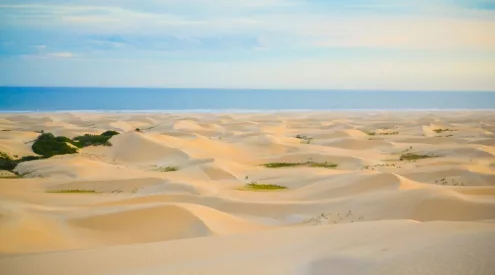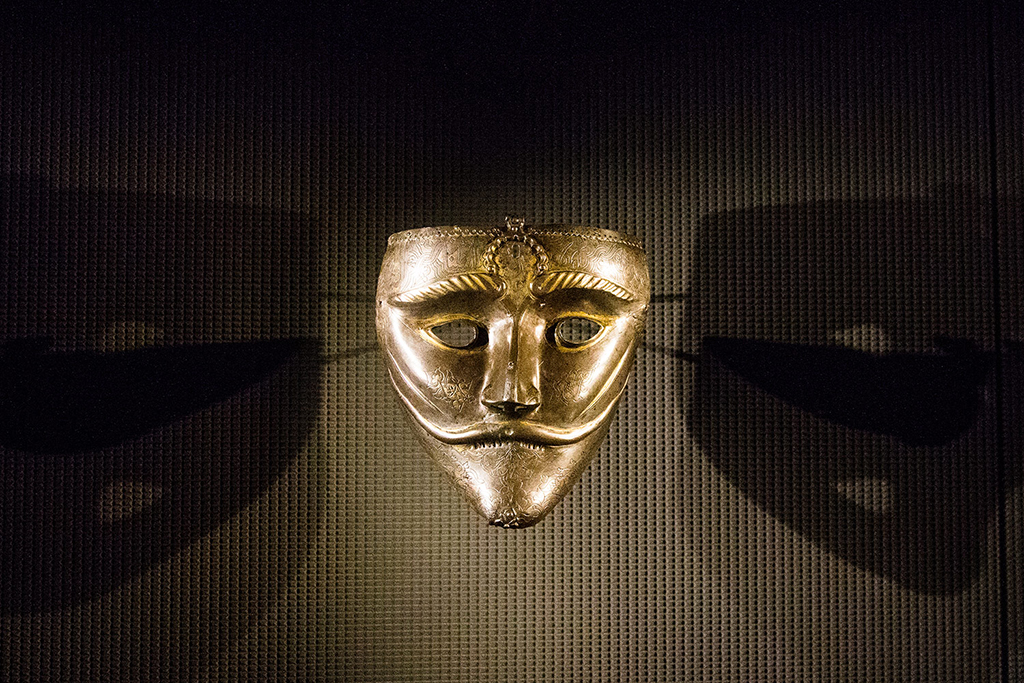Figuring out Doha, for most travellers, boils down to figuring out how to get from Gate A to E via the doughnut stand. Qatar is a small country in the middle of not very much, and for most South Africans it’s simply the linchpin in the flight-booking system that catapults them to Thailand, or Paris, or other places less beset by desert and heat. I was there to figure out if we were all missing a trick. Photos and words by Kati Auld.

Looking across the bay from the Museum of Islamic Arts.
Lonely Planet once called Qatar the most boring country in the world. After three days here, I know that it’s wrong – but I haven’t figured out which description to use instead. I’ve seen a lot of its capital city, Doha. I’ve been impressed by the towering hubris of the architecture, paid R260 for a glass of wine, and eaten my body weight in hummus, studded with pomegranate. But I haven’t understood this city.

Left, the Fanar Qatar Islamic Cultural centre, one of the city’s most recognisable landmarks. Right, traditional coffee is served lightly roasted, and heavy on the tongue with cardamom and cloves.
Doha is half jewellery box, half construction site. It’s impossible to overstate how much building is happening – train tracks being laid, highways twisting around piles of sand and brick and holes in the ground, cranes punctuating the skyline. This is part of the development towards the Fifa World Cup, which is being hosted here in 2022.
It feels like a time lapse of a city coming together, and all of the puzzle pieces are unfamiliar. The traffic department looks like a luxury hotel. The luxury hotels look like spaceships.

The magnificent oculus at the top of the Museum of Islamic Art’s ceiling is faceted to capture and reflect light.
In a confusing city, a good place to find your bearings is in the past. The Museum of Islamic Art is considered one of the top attractions in Doha, alongside a super-mall riddled with canals (complete with gondolas to take you from Vuitton to Gucci). Perhaps Islamic art only draws to mind antiquated Korans and dusty carpets – but there’s a ruby scabbard from India, tiles from Syria, an incense box, a perfume bottle that still looks covered in ancient dust. I want to hold it, to smell if there’s any hint of the scent it once contained. There’s a war mask from the 15th century. It’s steel, with gold inlay, and so carefully embellished it looks like it was made with the intention of being here, in an art museum, rather than on the face of a man on horseback.

A war mask, from eastern Turkey or Iran.
The scope of the museum, in a geographical sense as well as a historical one, is dizzying. From chain-mail equine armour to elaborate candlesticks, the overwhelming impression is of a million different worlds spinning gently beside each other. Doha is like this in more ways than one. Qataris make up only 18 percent of the population – which means it’s a wonderland for difference. I met people from Jordan, from Iran, from Bangladesh, from Kenya, from Britain, from Macedonia.

Abandoned during the day, these portable snack counters bustle with customers in the evenings.
You can eat margogah (a gelatinous mix of chicken and bread, spiced with cardamom and small hot peppers) at a kilim-covered table at the souk, and follow that with succulent beef brisket at the W Doha Hotel, surrounded by starchy businessmen. Later that afternoon I discussed the meaning of love with a very serious Nepalese taxi driver. We passed Swiss bakeries and Moroccan tailors, dust heavy in the air.
Doha gave me something I didn’t even know I was lacking – an introduction to the complexities of the Middle East. It doesn’t have the mighty sprawl of Dubai, and the laws aren’t as oppressive as the neighbouring Saudi Arabia. It’s compact, shiny, fascinating, and in the three days that I spent here I felt like I had discovered an unfamiliar new world.

Colourful falcon-shaped kites soar above Doha’s modern skyline at Sheraton Park.
It’s a public holiday in Doha when I go strolling along Al Corniche (the promenade) and come across Sheraton Park. Families are getting stuck in: cheap camping chairs, picnic blankets, slow-cooker pots big enough to stew a rhino. The Persian Gulf is right here, but the wild smell of the sea isn’t. Instead, masala wafts from pots, the Costa on the edge of the promenade is basting the breeze with cinnamon sugar, and the road right behind us adds a hint of exhaust fumes. The kids have been set loose and they run everywhere, with the universal abandon of barefoot children with lawn underfoot. It seems like every third child has a falcon-shaped kite. (Falcons are a big deal here – most men own one, and there’s even a state-subsidised falcon hospital to make them easier to maintain.) The falcon kites make me think of the gold, embossed falcon on an iPhone cover I saw earlier at the souk. When converting the price tag, it was worth as much as my car back home.
But watching these falcons, twisting and turning in their invisible gyres, against the buildings, reflecting gold back at me from their millions of faceted facades like sequins – well, this doesn’t cost a thing.

At sunset, strolling along the Corniche will give you the best view of the city.
Getting there
There are direct flights from Joburg to Hamad International Airport from R7 735 return with Qatar Airways; there are also direct flights from Cape Town. qatarairways.com
When to go to Doha
Visit between November and April to avoid the beastly hot summers – although almost everything is air-conditioned, so if your itinerary is mostly indoors, you might not even notice.
What you need to know
Visas need to be applied for beforehand – they cost R2 500 and are usually processed within seven to 10 working days, though you should allow 15 to 30 days. The visa application documents can be found at qatarembassy.za.net. English is widely spoken. Women should keep their elbows, shoulders and knees covered. The weekend is Friday and Saturday, rather than Saturday and Sunday. Alcohol is only available at certain five-star hotels, and bears the price tag to match. You can get around fairly easily in the turquoise Karwa taxis – about R83 (QR20) for a 10-minute ride.
Things to do in Doha
Go to the Museum of Islamic Art. Even better, go twice: it’s hard to fully appreciate an entire museum in one go. There are four floors of artefacts, from those related to science and calligraphy to everyday ornaments that belonged to emperors and sultans, spanning more than 2000 years. Entrance is free and the museum is closed on Tuesdays. mia.org.qa
Visit Mathaf Arab Museum of Modern Art. It was started as a private collection in the 1990s, by the emir, who was interested in curating the stories of art and culture from the Islamic world. The collection was donated to the Qatar Foundation, and now stocks over 9 000 pieces. It left me feeling exhilarated, my mind stretched in the way that good art should do. It is open from 11am – 6pm Wednesday to Sunday and 3pm – 8pm on Fridays. mathaf.org.qa
Paddle in the mangroves of Al Khor. You’d never believe that 45 minutes from the concrete heat of Doha you can be surrounded by clear water, the thick greenery of mangroves amid listening to birdlife. It costs from R830 pp excluding transport to and from Al Khor. aquasportsqatar.com

A five-minute camel ride through the sandy dunes just outside the city is a popular tourist attraction. Not for me, though.
Where to stay in Doha
K108 Hotel is a brilliant find: the rooms are as neat as a pin, there’s a swimming pool on the roof and it’s within walking distance of the Museum of Islamic Art. From R1282 per person sharing B&B. k108hotel.com

The inviting rooftop pool at K108 Hotel – the view of Doha from up here isn’t bad either.
Al Najada Boutique Hotel is on one of the quieter sides of Souq Waqif: it’s close to everything without the noise pollution. Rooms are large and beautifully furnished. From R1004 per person sharing. swbh.com
Where to eat and drink in Doha
Damasca One in the Souq Waqif is known for its shisha balcony and Syrian food. Get a selection of appetisers, so you can sample everything. From R113 per appetiser. damascarestaurant.com
Spice Market at the W Doha Hotel is known for its brunches, and exquisite South Asian-style food. It’s certainly not cheap – but if you splash out on one gourmet experience while in Doha, let it be this one. From R1163 for a three-course set menu. spicemarketdoha.com
Souq Waqif is peppered with hole-in-the-wall restaurants that sell Qatari food at great prices. There’s a good one on an unnamed alley just north-east of Damasca One. The sign is in Arabic, but you’ll know it’s the right place by the kilim-covered tables. From R84 for a massive serving of margogah and nakki (chickpeas).
The Cellar at the Oryx Rotana Doha is a nice spot for Spanish-style tapas, and it has a good wine list – albeit at prices that will ensure you have only one glass. From R211 for tapas. rotana.com/oryxrotana
This story first appeared in the August 2016 issue of Getaway magazine.
Our August issue features Mana Pools, great North West parks, and best trips for women. On shelves from 25 July.































